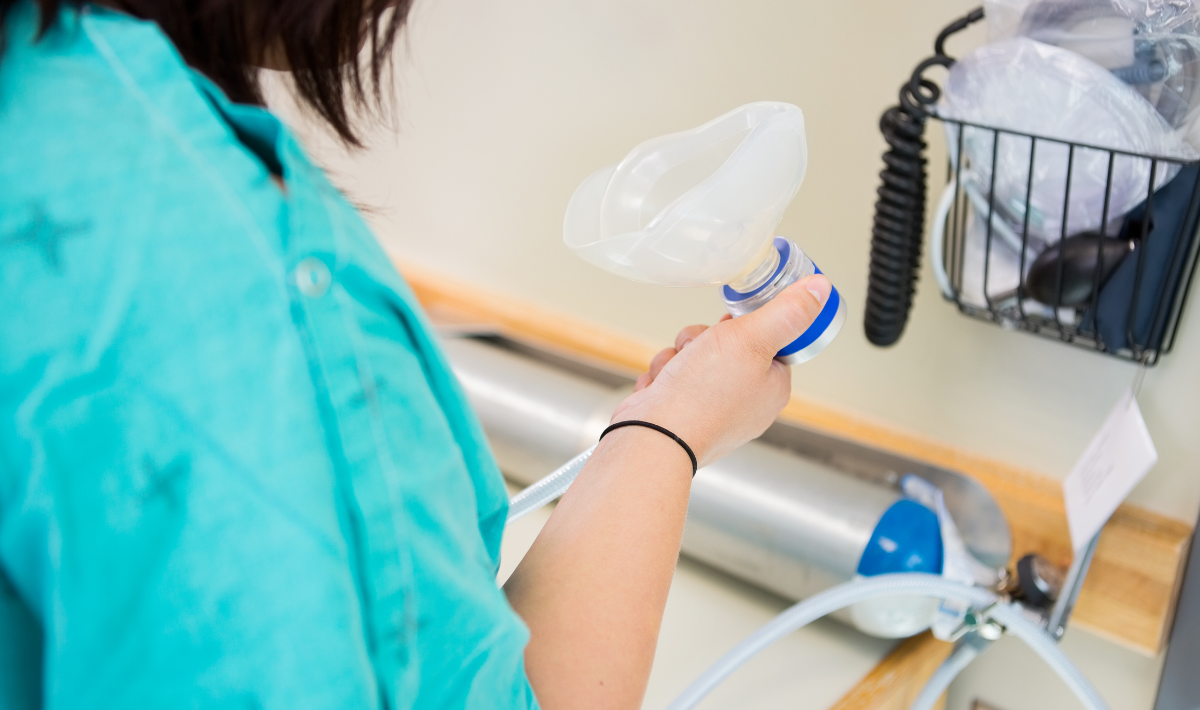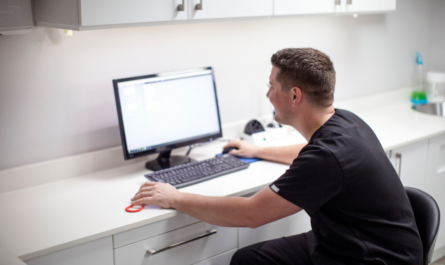By E. Daniel Shoemaker, national product trainer, Accutron Inc.
Outfitting a dental group practice with nitrous oxide calls for strategy and knowhow. First and foremost, safety must be taken into consideration. Patient and staff safety are of the greatest concern when medical gasses are being plumbed into a facility. The National Fire Protection Agency (NFPA) requires that the plumbers and installers of the actual piping system be certified as medical gas installers, and that each system be verified for safety by a third-party verifier who has no financial involvement in the sale or installation of any of the devices on the system. The verifier is the best friend to the dentist and others who may use the medical gas system, as he or she tests every function of the equipment and takes readings on the gasses coming out of every medical gas outlet. Every office should have a certificate of verification from a third-party verifier. This is of the highest safety priority and eliminates any chance of a crossed line, improper piping risers or other errors by the installers.
As group practices become larger, building planners are using the space provided to create multiple levels or multiple hallways of dental procedure areas. A few factors must be taken into consideration when planning these offices of the future.
To begin with, the location of the medical gas storage room in relation to the dental procedure areas has a bearing on what devices are required. Automatic switchover manifolds are required in several scenarios. Even when they are not required, however, they are a tremendous advantage for the dental staff, as they have indicators to alert and warn the staff of the simplest need, such as reminding them to order a replacement cylinder when one is depleted of gas. Zones of dental procedure areas are established when separations are created by distance, levels (i.e., floors) and access doors. The NFPA 99 standard stipulates the safety devices that are required for all nitrous oxide/oxygen systems, particularly when complications of multiple zones of procedure areas are created.
The NFPA Category 3 permits up to two alarm panels and up to four multiple zone valves to share a single manifold system. This allows the facility to share a single manifold system between two alarm panel locations (e.g., floor 1 and floor 2, or hall A and hall B), as well as allows for multiple zone valve locations. These zone valve requirements may vary by local codes.
At some point in the design process, the dental team will ask itself an age-old question: “Do we set up all the rooms the same, or should we have special rooms for special procedures?” This is usually followed up with: “Should we furnish hygiene rooms differently than the doctor’s rooms?”
A wise doctor once told me he set up his hygiene rooms as the nicest rooms in the office so that the one and only “first impression” of the office and staff would be his best foot forward. “The average new patient contributes a production level of approximately three times that of a current patient,” he said. “That’s why it’s so important to make an excellent first impression. The patient sees that yours is a caring practice dedicated to providing excellent dentistry, and the patient in turn becomes dedicated to the practice.”
Different rooms, same setup
Another trend is to set up all the dental equipment and facilities in the treatment rooms exactly the same. Hygiene rooms are decorated and set up typically as educational rooms, but when it comes to the chair, unit, light, nitrous equipment, etc., every room in the dental office is exactly the same. There is added efficiency of managing patient flow when all rooms are set up this way. Time is the one commodity that you can’t replace or add to the practice. Equipment and practice techniques that can increase effective use of the practice’s time have the potential to pay back and generate profit. Don Hobbs, VP of Equipment at Henry Schein, told First Impressions Magazine, a sister publication to Efficiency in Group Practice, “Dentistry has evolved, and now we recommend that all the rooms are consistent and designed as full treatment suites. That concept enables doctors to treat some patients immediately, as opposed to re-appointing. It is better for the patient, as they do not have to come back, and it is better for the doctor, as it leads to a more efficient and profitable practice.”
With regard to specialties (e.g., endodontics, periodontics, orthodontics, implants, etc.), specialty carts can be outfitted to move between treatment rooms as needed, providing all the specialty devices necessary while bringing the specialty to the patient, no matter where he or she is seated in the office.
Infection control
There is seldom a single word used more frequently when discussing dental procedure room equipment than asepsis. The importance of wiping down or barrier-protecting any device in the range of the overspray from the patient’s mouth is right up there with sterilization of instruments, handpieces, etc. It’s all about cross-contamination control, and any device with dials, knobs, levers, switches or handles impedes the process. Nitrous delivery flowmeters that are mounted into the cabinetry or wall and that have flat screen controls help prevent cross-contamination between patients. The simple act of removing barriers from just one more added device, like the face of the flowmeter, only takes a few extra seconds and is so much more effective than cleaning around dials, knobs, levers, switches and handles.
Another element in asepsis control is that of the nasal hood that the patient breathes through. The need to wipe out a nasal hood with a four-by-four dipped in alcohol has been replaced by autoclaveable or disposable hoods. Think about how much time is required to wash and clean a nasal hood, let it dry, place it in a sterilization bag, make room in the sterilizer (usually accomplished by removing a tray, which reduces the amount of instruments the staff can sterilize in a cycle), pass it through sterilization and then return it to the operatory. Disposable nasal hoods are real time-savers.
Today, the portions of the scavenging circuit hoses that actually touch the patient are autoclaveable. While changing out the mask is a good practice to prevent cross-contamination, the practice should consider establishing a protocol to clean and sterilize the portion of the hoses that come in contact with the patient.
As recent as January 2014, any procedure that includes levels of sedation that are moderate, deep or general requires the use of a capnography monitor to track end-tidal carbon dioxide (EtCO2). Various methods have been attempted to place the EtCO2 sample tube as near to the exhalation of the patient as possible, but Accutron Inc. has discovered that a short extension tube built into the nasal hood allows for the best fit of the mask, while providing the most accurate location for CO2 sampling.
Scavenging
While on the subject of hoses and masks, the other side of the medical gas delivery is the vacuum removal of the exhaled gas, titled “scavenging.” Scavenging needs to be figured into the design of the dental vacuum system, usually figured as half of a “user.” (A “user” is typically defined as a high-volume hose opening, and systems are designed by adding up the number of high-volume evacuators, saliva ejectors and nitrous scavengers that are in use at the same time.) The load isn’t extreme, but it needs to be calculated into the design.
As dentists and hygienists incorporate the practice of minimal class movements, unencumbered access around the patient’s head is required. Hoses and wires draped between the rear cabinetry can block or reduce access to the patient. A growing trend for nitrous oxide delivery hoses is to run the mixed gas and vacuum hoses from the cabinetry behind the head of the patient, through a conduit under the floor, and mount the delivery side of the system on the dental chair, draping the hoses under the back of the chair, up to the patient. This system gives the dentist unencumbered access to the patient.
As mentioned previously, the first concern in the building of a dental office is the safety of the patients and the staff. Although practices rarely must call for emergency services to assist with a patient or staff member, the office staff should all be CPR-certified and the proper emergency equipment should be on hand. A portable oxygen cylinder with a demand valve resuscitator constitutes the minimal safety equipment. Even if the central system has outlets that allow connecting into the oxygen for emergencies, the central system does not reach the bathrooms, hallways, waiting room, elevators, etc., and more heart attacks occur away from the operatory than in it. Centrally located automatic external defibrillators (AEDs) should be considered a must-have, and large group practices that span out or have multiple levels might require several.
Editor’s note: E. Daniel Shoemaker joined the dental industry in 1974 and has held positions as technician, service manager, national service manager, manufacturer sales representative, field product manager, regional sales manager, and national product trainer for several companies. He has lectured at over 200 training meetings on various aspects of nitrous oxide use in oral sedation and has served on the NFPA 99 sub-committee on medical gas piping for the past 20+ years, participating in the establishment of safety standards in North America. In addition, he has presented at the national meetings for Medical Gas Professional Healthcare Organization, National Piping Engineers meetings, and several teaching institutions.
Key considerations
Nitrous oxide plays an important role in the dental practice. Some key factors to consider when designing the operatory include:
- Compliance with NFPA codes and regulations.
- Installation of a central gas supply system.
- Selection of an automatic manifold system that allows for more than one alarm panel.
- Furnishing each operatory with the same fixed nitrous oxide flowmeter.
- Selection of flowmeters that are easy to disinfect or barrier-protect.
- Scavenging expelled nitrous oxide. (The size and force of the vacuum system needs to be adequate enough to support all operatories.)
- Consideration of including a Capnography monitor.
- Eliminating gas and vacuum hoses that drape from cabinetry, crowding the work zone. (It’s important to locate the vacuum and gas delivery hoses at the patient chair.)
- Access to emergency oxygen equipment






Mr Shoemaker,
Thank you for taking the time to author this great article. Also thank you for your contribution to the latest edition 2018 of NFPA 99 especially Chapter 15 on Dental Gas and Vacuum Systems.
Although the new chapter makes it easier for dental offices to comply with these standards, it also makes it more evident that dental offices need to comply with NFPA 99.
Could you expound on the importance of properly designing the medical / dental gas systems, especially when performing sedation and general anesthesia? Many dental supply companies are not appropriately designing these systems for the uses described when you were discussing capnography. The ADA’s text on Dental Office Design points out now that dentists doing sedation and anesthesia must discuss this with local authorities having jurisdiction to ensure they comply with code.
As you stated, the verifier is the dentist and patient’s best friend. I completely agree with the sentiment, but who should dentists be working with early on to design the right Category system initially to avoid very costly mistakes that will potentially be caught by a 3rd party verifier? I speak from experience as you can see from our practice’s url below, hence why I ask.
Once again, excellent post and thank you for your expertise!
Jonathan Wong, DMD
http://www.coastalpediatricdental.com
Where can i find food grade nitrous oxide tanks that dont need medical licenses to purchase the gas.